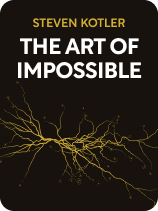

This article is an excerpt from the Shortform book guide to "The Art of Impossible" by Steven Kotler. Shortform has the world's best summaries and analyses of books you should be reading.
Like this article? Sign up for a free trial here .
How can you define your goals to make them actionable? After defining your goals, what next step should you take to achieve them?
Goals feel impossible when you see no discernible way to get from where you are to where you want to be. In The Art of Impossible, Steven Kotler draws on extensive neurobiological research to demystify how to define your goals and achieve breakthrough success.
Keep reading to learn Kotler’s advice on how to define your goals when you don’t know where to begin.
How to Define Your Goals With a Meaningful Purpose
To understand how to define your goals, Kotler says learning about and sharing your interests makes it easier to define your seemingly impossible goals. Kotler specifically advises exploring how your interests might solve a global problem.
According to Kotler, believing that you’re involved in something that has the potential to make a massive positive impact on the world shifts your attitude from “exploring something interesting” to “working toward something important.” This attitude shift transforms your exploratory work into a meaningful purpose that generates even more reward neurochemicals—resulting in decreased stress levels and increased levels of motivation, productivity, resiliency, and focus. Consequently, after you’ve decided how to define your goals, it will be easier to sustain long-term momentum and achieve your goals.
Exercise: How to Define Your Goals
Write down 15 global problems that you would love to see solved to help you define how your goals could make a positive impact. Be as specific as possible. For example, instead of, “End world hunger,” write: “Increase access to farming skills and technologies.” Then, consider how your personal interests could potentially solve one of these global problems. For example, your interest in using solar panels to grow produce all year round might lead to a solution that involves establishing a distribution network for agricultural solar technologies.
(Shortform note: Daniel H. Pink (Drive) clarifies how defining your goals and connecting them to a global problem increases your motivation: You’re biologically wired to want to help other people. Therefore, goals that don’t contribute to the well-being of others feel less meaningful—because they don’t align with your natural inclination to help others. Further, scientific research confirms that actively contributing to the well-being of others makes you happier: When you act with the intention of helping others, you activate the same parts of your brain that are stimulated by pleasurable activities such as eating good food or having great sex. This implies that goals feel more pleasurable the more people they serve—thus, validating Kotler’s approach to defining your goals.)
How to Fully Engage After Defining Your Goals
Now that we’ve explored how to define your goals, we’ll discuss how to fully engage in your purpose to achieve the goals you’ve set.
Spend two to six hours each week pursuing recreational activities that fully engage you so that you can benefit from the pleasurable advantages that all six reward chemicals offer. According to Kotler, the more you practice being fully engaged when you’re not working toward your goal, the easier you’ll find it to be fully engaged when you are working toward it. For example, you feel fully engaged when you hike through the woods, complete jigsaw puzzles, and bake cakes. You spend two hours each week pursuing each of these three activities—totaling six hours of full engagement.
(Shortform note: It’s true that the more you practice being fully engaged, the easier you find it to attain this state of mind. This is because it employs six of the most addictive reward neurochemicals at once—making it an addictive mental state. However, since being fully engaged continually pushes you outside of your comfort zone, it can create serious negative consequences—especially if your full engagement activities center around activities that involve a high degree of risk, such as base jumping or cave diving. Numerous extreme-sports athletes have lost their lives in the pursuit of chasing the thrill that full engagement offers. Therefore, proceed with caution: Focus on activities that don’t hinge on mastering death-defying stunts.)

———End of Preview———
Like what you just read? Read the rest of the world's best book summary and analysis of Steven Kotler's "The Art of Impossible" at Shortform .
Here's what you'll find in our full The Art of Impossible summary :
- A look at how some people can achieve seemingly impossible feats
- How to make your dreams more attainable
- A step-by-step process for developing peak performance habits






